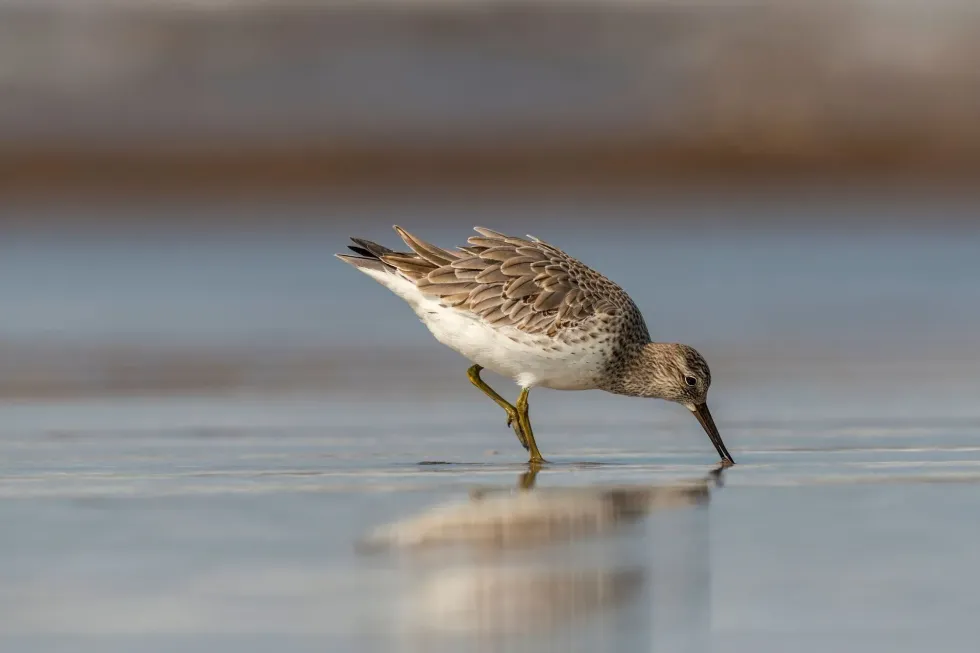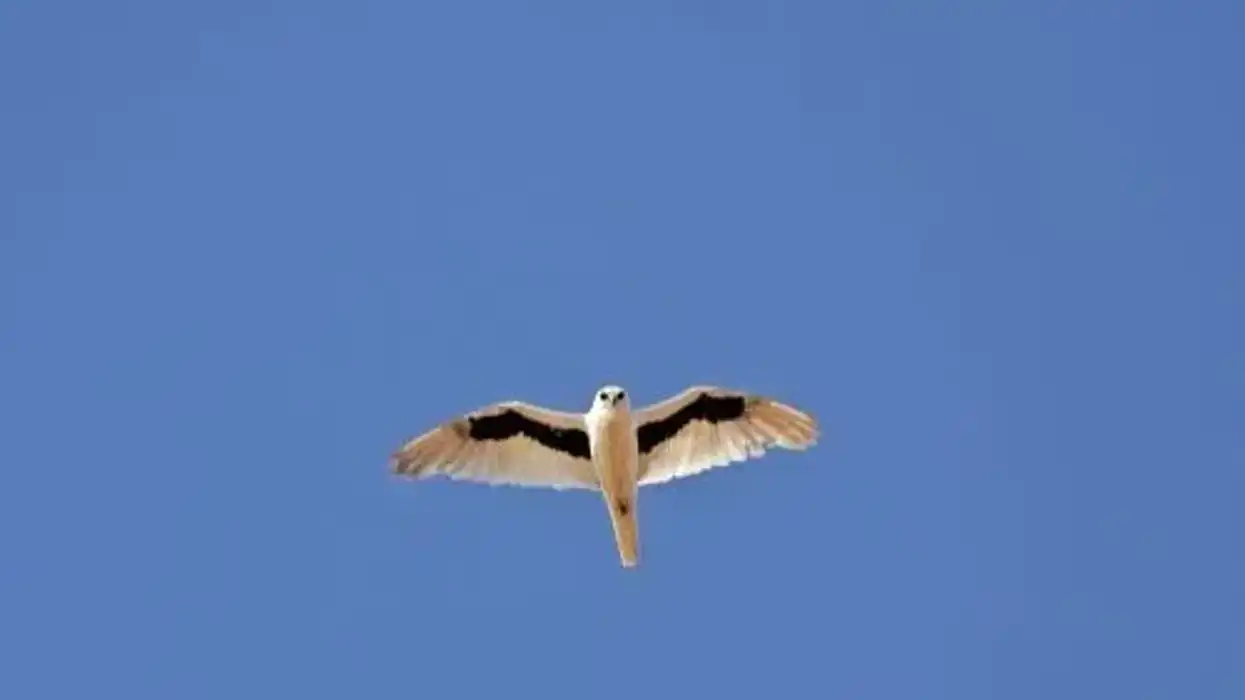The great knot (Calidris tenuirostris) is a wading bird species. It is stout, medium-sized, and almost exclusively found on intertidal mudflats and along shorelines during their non-breeding season in Australia.
However, the breeding habitat of this shorebird species includes rocky, mountainous areas of alpine and subalpine tundra in the Northern Hemisphere, particularly northeastern Siberia. Besides, these great knots undertake long-distance migration.
These birds winter throughout their coastal habitats in parts of southern Asia and the Middle East, South-east Asia through to Australia, with quite a few migratory stopover areas in between. The Yellow Sea is a significant stopover site where this species forms enormous flocks in spring, with numbers going up to around 80,000 according to a 2013 survey.
Great knots sport distinct breeding and non-breeding plumage. The adult birds in breeding plumage typically have a breast and flanks with heavy black spotting and a prominent brick-orange patch on the streaked upperwings.
Non-breeding birds are relatively paler with grayish-brown upperparts, upper breast and neck with gray mottling, and white underparts. The bill is of medium length, tapering, slightly thick, and pretty much longer than the head.
These migratory birds have quite a varied diet and eat anything from berries and seeds to insects and crabs. Unfortunately, the great knot is an Endangered species with several reasons contributing to a decline in its population.
There's more to great knots that you'll be surprised to know. Read on to find out! You may also read about other bird species and interesting facts about parrots and woodpeckers.
Great Knot Interesting Facts
What type of animal is a great knot?
The great knot (Calidris tenuirostris) is a wading bird or shorebird species of the family Scolopacidae.
What class of animal does a great knot belong to?
The great knot (Calidris tenuirostris) belongs to the class of birds (class Aves).
How many great knots are there in the world?
No data is available regarding the present population size of the great knot. However, this species has a declining population trend.
Where does a great knot live?
The great knot (Calidris tenuirostris) does not prefer inland habitats. The wintering habitat of these birds includes sheltered coastal habitats such as intertidal sand and mudflats, harbors, bays, inlets, lagoons, estuaries, ocean beaches, and shorelines. This species breeds in tundra regions with habitats characterized by plateaus or gentle slopes.
What is a great knot's habitat?
Great knots breed in the Northern Hemisphere in northeastern Siberia, Russia. These birds mainly winter in Australia but also occur throughout the coastal regions of South-east Asia, along the coasts of India, Pakistan, and Bangladesh in southern Asia, and the eastern coast of the Arabian Peninsula.
These birds undertake long-distance migration in spring and fall with prominent migratory stopover sites located in the Yellow Sea of North Korea, China, and South Korea.
While these birds prefer large intertidal areas and beaches for feeding and roosting, the breeding ground of this species is typically a rocky or gravelly area with patches of lichen, herbs, heather, larch, or dwarf pine.
In the breeding habitat of this species in the montane, subarctic regions, the great knot can be found at heights ranging from 984-5,249 ft (300-1,599.8 m).
Who do great knot live with?
Great knots are known to forage in flocks with individuals ranging from a few hundred to several thousand. This species forms enormous flocks during the winter season.
How long does a great knot live?
While the exact lifespan of the great knot is unavailable, the oldest ringed bird of this species is reported to be of at least 10 years.
How do they reproduce?
Great knots nest in monogamous pairs in their breeding grounds in northeastern Siberia. The breeding season spans from late May to late June. These birds leave their breeding grounds in July and begin their voyage to the Australian and southern Asian wintering coasts, where they arrive between August and October.
The nest is usually a lichen-lined depression on the ground where the female bird lays a clutch of about four eggs that are grayish-yellow with reddish-brown marks. They are laid over a period of five days and undergo incubation period of about three weeks.
While both parents participate in egg incubation, only the male birds look after the broods of the young. The chicks take around 20-25 days to fledge.
What is their conservation status?
According to the International Union for Conservation of Nature (IUCN) Red List of Threatened Species, the great knot (Calidris tenuirostris) is has a conservation status of Endangered with a decreasing population trend.
Great Knot Fun Facts
What do great knot look like?
This migratory great knot of the wader family Scolopacidae has distinctive breeding and non-breeding plumage. This bird is medium-sized with a stout build.
The characteristic physical features of these birds include a thick and tapering bill of medium length but longer than the head, a finely streaked eyebrow stripe, a dark-spotted breast, densely-streaked forehead, and a whitish rump visible in flight. These birds have well-defined V-shaped markings on the flanks and short, dark legs.
In their breeding plumage, the chest of the bird becomes heavily mottled in black, the back becomes blackish, and the upperparts don a black and red feathering.
Moreover, the V-shaped markings on the flanks become more prominent in breeding adults. By the time the birds land on the Australian wintering ground, the plumage assumes the non-breeding form characterized by paler gray breast and upperparts, dark gray-streaked head and neck, streaked breast, and flanks with light streaks.
The juvenile birds are more or less like the non-breeding adults but browner and darker.

How cute are they?
The great knot is not conventionally cute. However, the stout build, small head, tapering bill, and short legs of this medium-sized bird do lend it an adorable look.
How do they communicate?
Away from the nesting ground, the great knot is a pretty much silent bird. The flight call is usually a sharp and whistly 'kweet-kweet'.
While a soft whistling sound has also been reported during the breeding season, the calls are not very well described. In the non-breeding site, these birds may be heard giving out a low 'nyut-nyut' or 'chucker-chucker-chucker' calls.
How big is a great knot?
The great knot ranges in size between 10.2-11 in (26-28 cm) with a wingspan of 22-26 in (55.8-66 cm). These birds are slightly larger in size than the red knot (Calidris canutus), the largest calidridine sandpipers of North America. Compared to the great knot, the red knot has a rusty-red breeding plumage.
How fast can a great knot fly?
An estimate of the flight speed of great knots is unavailable. However, juvenile birds of this species have a record of flying almost 1,864 mi (2999.8 km) within 10 days during migration. Considering that, these birds do seem to have exceptional flying abilities because they migrate each year.
How much does a great knot weigh?
The great knot weighs about 4.05-8.74 oz (114.8-247.7 g). It is comparatively heavier than the red knot.
What are the male and female names of the species?
Male and female great knots do not have distinct names.
What would you call a baby great knot?
A baby great knot is called a chick.
What do they eat?
During the breeding season, these birds feed on plant materials such as berries and seeds. Their diet includes insects such as spiders and beetles and invertebrates like bivalve mollusks, shrimps, crabs, sea cucumbers, snails, and worms.
Are they dangerous?
The great knot is not known to be dangerous.
Would they make a good pet?
Great knots are wild birds with specific habitat and food requirements. They have a declining global population and so, it is best not to try and make a pet out of them.
Did you know...
Low numbers of great knots have been reported from western Alaska, and the birds are vagrant in West Virginia, Oregon, and Maine in the United States as well as New Caledonia, Mauritius, the Seychelles, South Africa, Namibia, Uganda, Djibouti, Iran, Britain, Germany, the Netherlands, Spain, Norway, Morocco, and Israel.
The feeding areas of great knots include large intertidal areas and coasts where these birds jab their bill into the soft mud to catch prey.
Why is the great knot endangered?
The major threats to the great knot's habitat include habitat loss and degradation, hunting, pollution, and unfavorable land management.
How many eggs do great knot lay?
A female great knot lays a clutch of about four eggs.
Here at Kidadl, we have carefully created lots of interesting family-friendly animal facts for everyone to discover! For more relatable content, check out these radjah shelduck facts and yellow warbler facts for kids.
You can even occupy yourself at home by coloring in one of our free printable mallard duck coloring pages.
Second image by sunphlo from South Australia.










